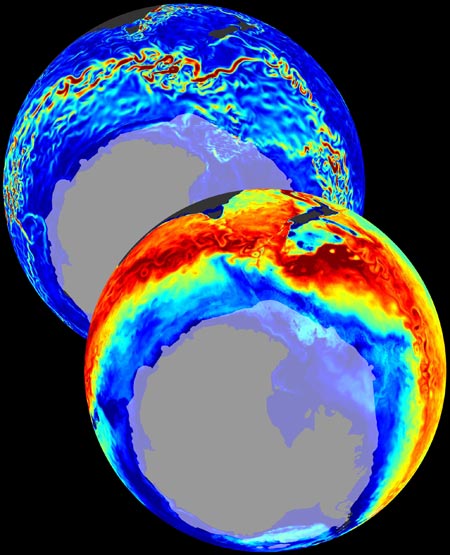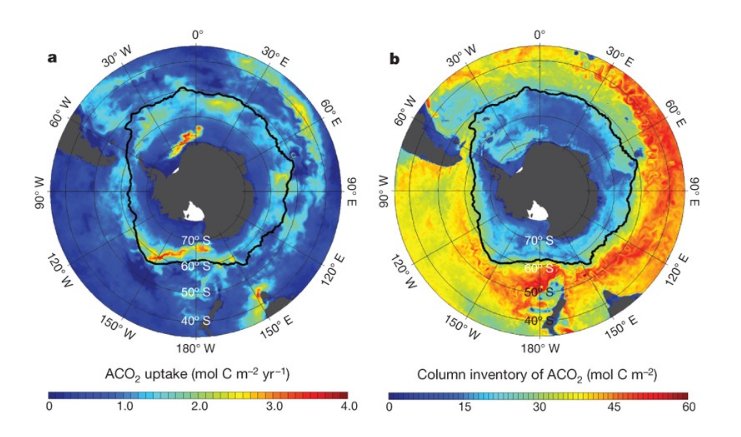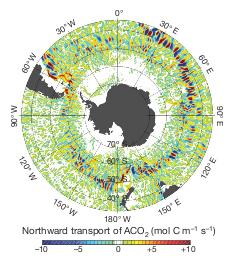
In and out. Driven by winds, the Southern Ocean’s currents (blue globe) transport CO2 (red) northward. Credit: T. Ito et al., Nature 463 (2010)
story by Helen Hill

In this article we spotlight work by Taka Ito, Molly Woloszyn and Matt Mazloff who have been using MITgcm to study anthropogenic CO2 transport in the Southern Ocean.
Key to their study is a high-resolution (1/6o x 1/6o) estimate of the Southern Ocean circulation, consistent with modern observations, deriving from an MITgcm adjoint calculation, developed as part of the ECCO-GODAE project. In addition MITgcm’s offline model enabled a ready coupling of the high resolution circulation estimate to a carbon cycle model.
Focusing on intra-annual ACO2 variability, the team found a clear correlation between the pattern of carbon uptake and oceanic vertical exchange in strong support of the wind-driven circulation as a primary regulator of Southern Ocean ACO2 transport.

Figure 2a: The 2 year mean of ACO2 uptake rates evaluated between January 2005 and December 2006; 2b: The column inventory of ACO2 (storage) determined from a 5 day mean in December 2006. The solid back line represents the position of the Antarctic Polar Front calculated from satellite observations of sea surface temperature.
As seen in Fig 2a, ACO2 peaks around the Antarctic Polar Front. A column inventory (Fig 2b) demonstrates how the circulation distributes the ACO2.
Thanks to its large surface area and vigorous overturning circulation, the Southern Ocean has the potential to be a substantial sink of ACO2. Despite its importance, however, the mechanism and pathways of ACO2 uptake and transport remain poorly understood. To contribute to the current debate surrounding the details of the Southern Ocean carbon sink, the team used an MITgcm high-resolution ocean circulation and carbon cycle model built. Focussing on intra-annual variability, Ito, Woloszyn and Mazloff, used their model to investigate the interplay of Ekman flow, ocean eddies and subduction which lead to the observed advection of dissolved carbon away from the front.
Based on their model results, they were able to show that the pattern of carbon uptake and that of oceanic vertical exchange are correlated, with zonally integrated carbon uptake peaking at the Antarctic polar front. While they observed that the imprint of mesoscale eddies locally dominates lateral carbon fluxes, they were able to demonstrate that it was Ekman transport that was the primary mechanism for the zonally integrated, cross-frontal transport of ACO2. Figure 3a shows the vertically integrated northward ACO2 transport while Fig 3b shows the zonally and temporally integrated magnitudes of northward ACO2 flux. The results highlight the importance of wind-driven transport across the polar front and subduction at the subtropical front: Intra-annual variability of the cross-frontal transport is dominated by the Ekman flow with little compensation from eddies.
Read more about this work in the Science NOW article “Southern Winds Help Stash Earth’s Carbon Dioxide”, or the Nature article “Anthropogenic carbon dioxide transport in the Southern Ocean driven by Ekman flow”. Still got questions? Contact Taka…
Publications:
Ito T., M. Woloszyn and M. Mazloff, (2010), Anthropogenic carbon dioxide transport in the Southern Ocean driven by Ekman flow, Nature, 463, 80-83 (http://www.nature.com/nature/journal/v463/n7277/abs/nature08687.html)




